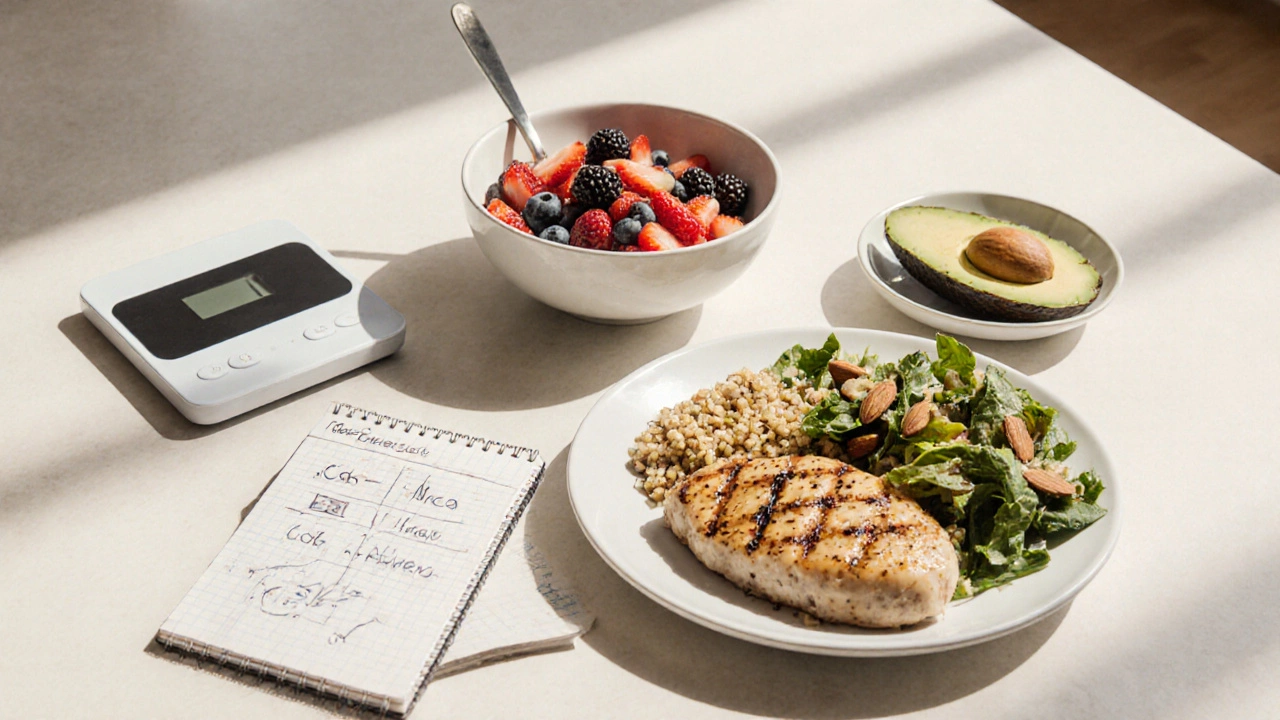
40-30-30 Macronutrient Calculator
Daily Calorie Target Calculator
Enter your daily calorie goal to see how it breaks down into 40% carbs, 30% protein, and 30% fat.
Ever wondered why some diet plans keep popping up with a 40‑30‑30 split? That number isn’t random - it’s a macro‑balanced approach designed to keep hunger at bay while still creating a calorie deficit for weight loss.
What the 40‑30‑30 Rule Actually Is
40‑30‑30 rule is a dietary framework that allocates 40% of daily calories to carbohydrates, 30% to protein, and the remaining 30% to fats. By dividing calories this way, the plan aims to supply enough energy for workouts, preserve lean muscle, and still promote steady fat loss. The concept originated in the early 2000s and gained traction among fitness enthusiasts who wanted a simple, science‑backed macro split.
How the Numbers Add Up
First, you need a baseline - your total daily energy expenditure (TDEE). TDEE is the total calories you burn in a day, factoring in basal metabolic rate (BMR) plus activity. Once you have that figure, subtract 10‑20% to create a calorie deficit. That reduced number becomes your target intake.
Next, split the target calories:
- Carbohydrates: 40% of total calories → each gram = 4 kcal.
- Protein: 30% of total calories → each gram = 4 kcal.
- Fats: 30% of total calories → each gram = 9 kcal.
For a 2,000‑kcal target, that translates to 200g carbs, 150g protein, and 67g fat.
Step‑by‑Step: Setting Up Your Personal 40‑30‑30 Plan
- Calculate your TDEE. Use an online calculator or the Mifflin‑St Jeor equation:
Men: (10×weightkg) + (6.25×heightcm) - (5×age) + 5
Women: (10×weightkg) + (6.25×heightcm) - (5×age) - 161 - Determine your deficit. Subtract 15% for moderate loss (e.g., 2,000kcal×0.85=1,700kcal).
- Apply the 40‑30‑30 split to the deficit calories.
- Convert each macro percentage to grams using the kcal‑per‑gram values.
- Log your meals in an app (MyFitnessPal, Cronometer) to stay on track.
Sample Day on the 40‑30‑30 Rule
Here’s a realistic 1,700‑kcal menu that hits the macro targets:
| Meal | Food | Calories | Carbs (g) | Protein (g) | Fat (g) |
|---|---|---|---|---|---|
| Breakfast | Greek yogurt (150g) + berries + 30g oats | 350 | 45 | 30 | 10 |
| Snack | Apple + 15g almonds | 200 | 30 | 5 | 10 |
| Lunch | Grilled chicken breast (120g) + quinoa (80g) + mixed veg | 450 | 45 | 45 | 12 |
| Snack | Cottage cheese (100g) + cucumber slices | 150 | 8 | 20 | 5 |
| Dinner | Salmon (100g) + sweet potato (150g) + broccoli | 550 | 45 | 50 | 20 |
| Total | 1,700 | 213 | 150 | 57 |
This plan keeps protein high (crucial for muscle preservation) while providing enough carbs for energy and a moderate amount of healthy fats.
Why the 40‑30‑30 Split Works
Three science‑backed reasons make this ratio popular:
- Protein saturation. Consuming ~1.2‑1.6g perkg body weight helps curb hunger hormones like ghrelin.
- Balanced energy. Carbs at 40% fuel high‑intensity workouts, preventing performance drops.
- Steady insulin response. A moderate carb load avoids the spikes that can trigger fat storage, while fats keep you feeling full longer.
Studies from the International Journal of Obesity (2022) showed participants on a 40‑30‑30 diet lost an average of 0.9kg per month, comparable to more restrictive plans but with higher adherence rates.
Common Pitfalls and How to Avoid Them
Even a well‑designed macro split can go off‑track if you ignore a few basics:
- Skipping the deficit. If you calculate TDEE wrong, you’ll eat at maintenance and see no change.
- Low‑quality carbs. Choose whole grains, fruits, and veg over refined sugars; otherwise you’ll feel sluggish.
- Neglecting fiber. Aim for 25‑30g daily; fiber helps digestion and satiety.
- Over‑relying on processed “high‑protein” foods. Real foods (lean meats, dairy, legumes) provide micronutrients that supplements lack.
Track your macros consistently for at least two weeks before tweaking. Small adjustments-like swapping 10g of carbs for extra veg-can fine‑tune results.

When the 40‑30‑30 Rule Might Not Be Ideal
Every plan has limits. Consider alternatives if you fall into one of these categories:
- Very low‑calorie needs. Athletes or bodybuilders often need a higher carb percentage (e.g., 50‑30‑20) for performance.
- Specific medical conditions. People with kidney disease may need to limit protein, while those with insulin resistance might benefit from lower carbs.
- Personal preference. If you dislike carbs, a 30‑40‑30 split (more protein) can feel easier to stick with.
Always consult a registered dietitian if you have health concerns before committing to any macro regimen.
| Plan | Carbs % | Protein % | Fat % | Typical Use‑Case |
|---|---|---|---|---|
| 40‑30‑30 | 40 | 30 | 30 | General weight loss, balanced activity |
| 50‑30‑20 | 50 | 30 | 20 | Endurance athletes, higher energy demand |
| 30‑40‑30 | 30 | 40 | 30 | Muscle‑building, higher protein need |
| Low‑Carb (20‑40‑40) | 20 | 40 | 40 | Insulin‑sensitive individuals, keto transition |
Quick Checklist for a Successful 40‑30‑30 Start
- Calculate accurate TDEE and set a 10‑15% calorie deficit.
- Convert the calorie goal into grams: carbs=0.4×cal/4, protein=0.3×cal/4, fats=0.3×cal/9.
- Choose whole‑food sources for each macro.
- Log every meal for at least 14 days.
- Re‑assess weekly: adjust calories if weight loss stalls >2weeks.
Frequently Asked Questions
Can I follow the 40‑30‑30 rule without counting calories?
It’s doable if you have a good sense of portion sizes, but counting calories for the first few weeks helps you calibrate your portions and avoid accidental over‑eating.
Is the 40‑30‑30 split suitable for vegetarians?
Absolutely. Swap animal protein for legumes, tofu, tempeh, Greek yogurt, and eggs. Just watch the combined protein content to hit the 30% target.
How fast can I expect to see results?
Most people notice a 1‑2kg drop in the first two weeks, mainly water weight. Sustainable fat loss of 0.5‑1kg per week follows when the deficit stays consistent.
Do I need supplements while on this plan?
If you eat a varied diet, supplements aren’t required. A multivitamin may help if you’re on a low‑calorie diet for more than 8‑12 weeks.
What’s the biggest mistake beginners make?
Skipping the deficit calculation and assuming a 2,000‑kcal baseline for everyone. Personalizing calories is the first step to any successful weight‑loss strategy.








